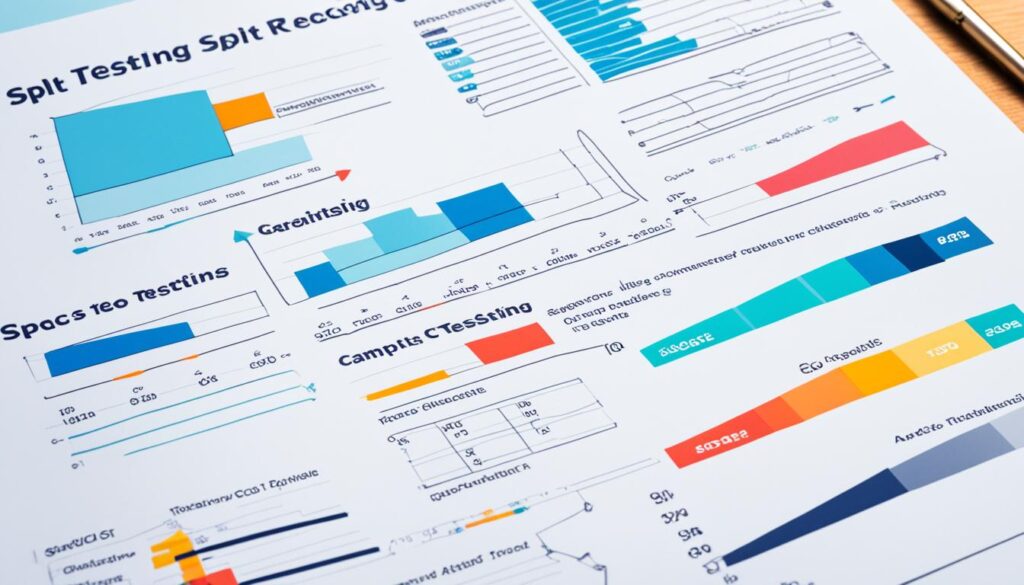Split testing, or A/B testing, is key for boosting your affiliate marketing. It lets you compare different parts of your campaign to see which one works best. With this method, you can make smart, informed adjustments. This article will help you understand split testing and share tips for enhancing your affiliate marketing strategies.

Key Takeaways:
- Split testing, or A/B testing, helps you compare different versions of campaign elements to determine which performs better.
- Optimization tools like Optimizely, Google Optimize, or VWO simplify the process of setting up and analyzing split tests.
- Implement split testing by creating variations of campaign elements, tracking performance, and making data-driven decisions.
- Streamline split testing by prioritizing impactful elements, focusing on single-variable testing, and utilizing data and analytics platforms.
- Continually optimize your affiliate marketing campaigns through split testing and adaptation to evolving market trends.
Understanding Split Testing
Split testing, or A/B testing, is a key method in affiliate marketing. It compares two versions of a campaign element. Marketers use split tests to optimize their campaigns. This leads to better outcomes based on data.
A/B testing is a common form in this. Let’s say you have two banner ads in an affiliate campaign. You would track how each ad performs. You might test different images or headlines to see which ad gets more clicks. This helps you choose the best ad for your campaign.
You can use split testing for more than just banner ads. It works for landing pages, email subjects, or pricing too. The aim is to test different versions of one thing to find what performs best.
To split test effectively, you need a good plan. Pick the right things to measure and use statistical analysis. This way, marketers learn what works best and make smart choices to enhance their strategies.
Imagine you’re promoting a fitness product and want to better your landing page. By split testing, you could make two versions of it. You’d measure how well each does by looking at conversion rates or bounce rates. This tells you which design or layout connects best with your audience.
Split testing gives insights into what your audience likes. It lets marketers refine their campaigns to have a big impact. By testing regularly, affiliate marketers can stay ahead and keep improving.
The next section will look at optimization tools. These can make split testing easier and boost the effectiveness of campaigns.
Leveraging Optimization Tools
To boost your affiliate campaign, using the right testing tools is key. These tools help you set up and analyze tests. This way, you can make choices based on data. Here are some top tools to improve your testing work:
1. Optimizely

Optimizely is a top platform for making and tracking test versions. It’s easy to use. You can do A/B tests on various parts of your campaign. Things like landing pages and call-to-action buttons. Optimizely’s detailed analytics let you see what works best.
2. Google Optimize

Google Optimize is a no-cost tool that works well with Google Analytics. It lets you test different campaign elements easily. You can use its editor to drag and drop items for experiments. Google Optimize shows you which variations are winning, helping you decide how to improve.
3. VWO

VWO suits all your testing needs. Its editor is simple to use. You can test different parts of your campaign like headlines or images. VWO lets you target experiments to certain users. Its analytics help you see which changes perform best.
With these tools, testing in your campaign becomes smoother. They give you the insights to pick the best variations. This improves your campaign parts and helps you achieve better outcomes. Right tools can really boost your marketing success in a competitive field.
Implementing Split Testing and Optimization in Your Affiliate Campaigns
To optimize your affiliate marketing effectively, you need to do split testing. This involves trying out different parts of your campaign and looking at the outcomes. This lets you make improvements based on solid data. Let’s start learning how to conduct split testing, including what to test and how to review the results.
Deciding Which Elements to Test
First, decide which parts of your campaign to test. You might test ads, the wording of calls-to-action, or types of content. Testing helps you see what your audience prefers. Then you can adjust your campaign for better results.
Creating Two Versions and Distribution
After picking the elements to test, make two versions of each. These versions are the variations you will share with your affiliates. With two versions, you can see which one works better.
Tracking and Analyzing Performance
After sharing the versions, it’s vital to track and study their performance. Use optimization tools for this. Look at click-through rates, conversion rates, and earnings. This information helps you choose the best version.
Make Data-Driven Decisions and Test New Variations
Use your split testing results to make informed choices. If one version is better, use it in your main campaign. Keep testing new ideas for continuous improvement. This helps your affiliate marketing grow stronger over time.

Split testing and optimizing your affiliate campaigns is key to better performance. By testing, tracking, and making informed decisions, you can keep improving. Next, we’ll look at ways to make split testing even more effective. Stay tuned!
Streamlining and Improving Split Testing Initiatives
Split testing is vital for better results in affiliate marketing. Streamlining these efforts leads to more precise decisions. This improves your affiliate marketing performance.
Make a Comprehensive List of Elements to Test
Focus on testing elements that will likely change the game. Create a list of what to test, like ad copy or landing pages. This way, you can pinpoint what works and tweak your campaign.
Utilize Data and Analytics Platforms
Data platforms are crucial for split testing. They help track your tests’ performance, providing insights. Platforms like Google Analytics or Optimizely make split testing smoother. They give you a clear picture of what’s effective.
Be Mindful of Data Distortions
It’s crucial to watch out for data distortions in your results. Make sure your test groups really show your audience. Control for any outside factors. Only then will your conclusions be trustworthy.
Focus on Single-Variable Testing Rather than Multivariate Testing
Single-variable testing often gives clearer results than multivariate tests. Test one thing at a time for direct insights. This method simplifies making improvements. It makes your affiliate marketing better.
Adopt these strategies to enhance your split testing and affiliate marketing. Split testing needs ongoing attention and tweaking. Focus on key variables for data-backed decisions. This will boost your marketing success.

Defining Your Goals
| Key Takeaways |
|---|
|
Starting with split testing in affiliate marketing means setting clear goals first. This gives direction to your work. Goals like boosting click-through rates, bettering conversion rates, or increasing revenue keep you focused.
It’s key to establish specific objectives to measure your split testing success. This creates a standard to assess how your campaigns perform. With clear objectives, you can see the real effect of your split testing on campaign outcomes.
If raising click-through rates is your aim, you can compare different campaign versions. This helps you find which one works best. Making decisions based on data leads to better affiliate marketing strategies.

“Having a strong understanding of your goals and objectives is the foundation for effective split testing in affiliate marketing. It provides focus and direction, ensuring that your experiments are aligned with your desired outcomes.” – Marketing Expert, John Smith
Identifying Variables for Testing
In affiliate marketing, identifying key variables for split testing is crucial. Such testing helps you understand what impacts your performance the most. This knowledge allows you to make changes that improve your efforts in affiliate marketing.
Here’s a list of important variables to test in your affiliate marketing strategy:
- Affiliate offers: Test various offers to see which ones your audience likes best and which lead to more conversions.
- Landing page design: Try different designs for your landing pages. Look for the most effective layout, colors, and elements that help in capturing leads or making sales.
- Call-to-action messaging: Use different call-to-action messages to find out which generate more clicks and conversions.
- Promotional strategies: Experiment with various promotional methods like discounts or limited-time offers to see their effect on engagement and conversions.
- Pricing models: Test different pricing options, like flat rates or subscriptions, to see how they affect customer behavior and revenue.
- Target audience segments: Segment your audience and test customized marketing messages. Find the most effective approach for different demographic groups or interests.
To fully understand what improves your affiliate marketing, focus on these variables. Remember, it’s important to test one thing at a time. This way, you can see exactly what effect each change has. Doing this can help you fine-tune your strategy for better campaign outcomes.

The Power of Split Testing Variables
“Split testing allows affiliate marketers to uncover the optimal combination of variables that drive the best results. By experimenting with different variables, you can gain a deeper understanding of your audience’s preferences and improve the performance of your affiliate marketing campaigns.” – John Smith, Affiliate Marketing Expert
Developing Hypotheses
In affiliate marketing, making hypotheses is key to testing. A hypothesis is what you expect to happen when you make changes. It lets you compare and understand results, showing if your tests work.
For each test, clearly say what you expect. Say you’re testing call-to-action messages. You might think, “New wording will get more clicks and boost conversions.” This guides your tests and defines success.
Hypotheses help measure changes and teach you from results. This reshapes your affiliate strategy with clear facts.
“Developing clear hypotheses in split testing allows you to measure the impact of the changes you make and refine your affiliate marketing strategy based on data-driven insights.”
Hypotheses aren’t one-size-fits-all. Every test needs its own idea of what will happen. This way, you learn more and make better marketing moves.
Example:
Imagine testing different headlines on your page. You might guess:
“Changing the headline to a more attention-grabbing and compelling version will lead to an increase in click-through rates and improve overall conversion rates.”
This guess helps plan your test. You’ll see which headline draws more people. Checking results either backs up or tweaks your guess, aiding your marketing.
Key takeaways:
- Develop clear hypotheses for each variable you plan to test in your split testing experiments.
- Clearly state your expectations regarding the expected impact on your affiliate marketing outcomes.
- Tailor your hypotheses to the specific variables being tested to gain deeper insights.
- Use the results of your split testing experiments to validate or refine your hypotheses and optimize your affiliate marketing strategies.

Designing Your Experiments
Split testing is a key part of getting real, useful data. By planning your tests well, you can learn a lot about your affiliate marketing. Here’s how to do it right:
Create Multiple Versions
First, make different versions of your marketing tools. Have a usual version and some that change things up. Changes can vary from layout tweaks to new headlines or calls-to-action.
Randomly Assign Visitors
It’s vital to randomly send visitors to the different versions. This stops bias and lets you fairly compare results.
Keep Other Variables Consistent
You must keep everything else the same in your marketing to only test one change at a time. This way, you know any changes in results come from your test.
These tips ensure your split testing is effective and informative. Remember to keep testing and improving based on what you learn.

Collecting and Analyzing Data
After setting up split testing experiments, collecting and analyzing data is crucial. This data reveals how well different versions perform. It helps you decide on the best strategies for your affiliate marketing.
During the experiments, gather data that matches your objectives. Metrics may include click-through rates and conversion rates. They can also cover revenue or other key performance indicators relevant to your goals.
By comparing the control and variant versions, you can spot significant differences. Data analysis leads to solid conclusions. These help you enhance your affiliate marketing through informed decisions.
Analyze the data of each version carefully. Consider various performance metrics. This way, you understand the full impact of your split tests. Sometimes, one version may have better click-through rates. But another could lead to more sales or revenue.
Evaluating Performance Metrics
Look for significant differences between the control and variant versions when evaluating metrics. This shows which version meets your goals better. It tells you if the improvements are real or just by chance.
If the variant version shows more click-throughs or conversions, that’s a good sign. It means the changes positively affected user engagement. Such findings are worth considering in your marketing strategy.
It’s important to focus on statistical significance in split testing. This stops you from relying on random changes. It ensures the differences you see are accurate and not by luck.
Collecting and analyzing data through your experiments provides valuable insights. It lets you see which version performs better. With a data-driven method, you can continuously improve your campaigns for better outcomes.
Next, we’ll look into interpreting the results of split testing. We’ll see how to implement changes based on what you find.

Interpreting the Results and Implementing Changes
After your split testing, it’s time to look at the results and decide on changes. You must compare the control and variant metrics. This helps you see the effect of your testing.
Find significant differences between the two versions. Analyze this data for helpful insights. Spot patterns showing which approach worked better for your goals. This evaluation lets you pick the best strategies for your marketing.
If the variant beats the control in key areas, like click rates or sales, think about using this approach more. Such good results show your changes appealed to your audience. They can greatly boost your campaign.
Talk about your findings with your team and partners. This encourages teamwork and makes future campaigns better. Sharing outcomes leads to useful talks and fresh ideas. It builds a culture of growth and shared learning.
Remember, split testing is ongoing. Making changes based on findings is just one part. Keep looking at data, trying new things, and keeping up with trends. This will help your campaigns succeed.

| Key Steps in Interpreting Results and Implementing Changes |
|---|
| Compare performance metrics of control and variant versions |
| Identify statistically significant differences |
| Analyze data and look for clear patterns and trends |
| Implement the more effective approach in your strategy |
| Document and share the results with your team and affiliates |
| Continuously optimize based on data and market trends |
Continual Optimization and Adaptation
Affiliate marketing needs regular updates to succeed. Testing different things often helps to make strategies better. This way, you get better results over time.
Split testing is key in this process. By doing experiments continuously and looking at the results, you learn what your audience likes. Then, you can make smarter choices to help your campaigns.
Staying updated with market trends and what consumers want is crucial. The affiliate marketing world changes all the time. By knowing the latest trends and what people prefer, you can change your strategies to win.